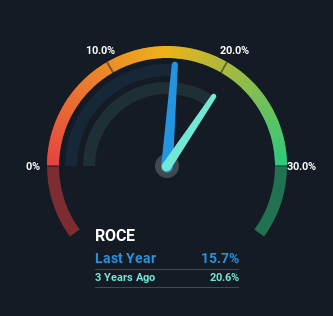Kitex Garments' (NSE:KITEX) Returns On Capital Not Reflecting Well On The Business

There are a few key trends to look for if we want to identify the next multi-bagger. Typically, we'll want to notice a trend of growing return on capital employed (ROCE) and alongside that, an expanding base of capital employed. If you see this, it typically means it's a company with a great business model and plenty of profitable reinvestment opportunities. In light of that, when we looked at Kitex Garments (NSE:KITEX) and its ROCE trend, we weren't exactly thrilled.
Understanding Return On Capital Employed (ROCE)
For those that aren't sure what ROCE is, it measures the amount of pre-tax profits a company can generate from the capital employed in its business. To calculate this metric for Kitex Garments, this is the formula:
Return on Capital Employed = Earnings Before Interest and Tax (EBIT) ÷ (Total Assets - Current Liabilities)
0.16 = ₹1.2b ÷ (₹8.4b - ₹837m) (Based on the trailing twelve months to December 2021).
So, Kitex Garments has an ROCE of 16%. In absolute terms, that's a pretty normal return, and it's somewhat close to the Luxury industry average of 14%.
View our latest analysis for Kitex Garments

While the past is not representative of the future, it can be helpful to know how a company has performed historically, which is why we have this chart above. If you'd like to look at how Kitex Garments has performed in the past in other metrics, you can view this free graph of past earnings, revenue and cash flow.
What Can We Tell From Kitex Garments' ROCE Trend?
On the surface, the trend of ROCE at Kitex Garments doesn't inspire confidence. Over the last five years, returns on capital have decreased to 16% from 36% five years ago. Although, given both revenue and the amount of assets employed in the business have increased, it could suggest the company is investing in growth, and the extra capital has led to a short-term reduction in ROCE. And if the increased capital generates additional returns, the business, and thus shareholders, will benefit in the long run.
On a side note, Kitex Garments has done well to pay down its current liabilities to 10% of total assets. So we could link some of this to the decrease in ROCE. What's more, this can reduce some aspects of risk to the business because now the company's suppliers or short-term creditors are funding less of its operations. Some would claim this reduces the business' efficiency at generating ROCE since it is now funding more of the operations with its own money.
The Bottom Line On Kitex Garments' ROCE
In summary, despite lower returns in the short term, we're encouraged to see that Kitex Garments is reinvesting for growth and has higher sales as a result. However, total returns to shareholders over the last five years have been flat, which could indicate these growth trends potentially aren't accounted for yet by investors. So we think it'd be worthwhile to look further into this stock given the trends look encouraging.
Since virtually every company faces some risks, it's worth knowing what they are, and we've spotted 2 warning signs for Kitex Garments (of which 1 is a bit concerning!) that you should know about.
While Kitex Garments isn't earning the highest return, check out this free list of companies that are earning high returns on equity with solid balance sheets.
Valuation is complex, but we're here to simplify it.
Discover if Kitex Garments might be undervalued or overvalued with our detailed analysis, featuring fair value estimates, potential risks, dividends, insider trades, and its financial condition.
Access Free AnalysisHave feedback on this article? Concerned about the content? Get in touch with us directly. Alternatively, email editorial-team (at) simplywallst.com.
This article by Simply Wall St is general in nature. We provide commentary based on historical data and analyst forecasts only using an unbiased methodology and our articles are not intended to be financial advice. It does not constitute a recommendation to buy or sell any stock, and does not take account of your objectives, or your financial situation. We aim to bring you long-term focused analysis driven by fundamental data. Note that our analysis may not factor in the latest price-sensitive company announcements or qualitative material. Simply Wall St has no position in any stocks mentioned.
About NSEI:KITEX
Kitex Garments
Manufactures and sells fabric and readymade garments for infants and children in India, the Unites States, and internationally.
Proven track record second-rate dividend payer.


